You are using an out of date browser. It may not display this or other websites correctly.
You should upgrade or use an alternative browser.
You should upgrade or use an alternative browser.
Tannoy Edinburgh 3149 become Tannoy Edinburgh Monitor Gold 12 !!!
- Thread starter ToTo Man
- Start date
Cable Monkey
A chip on both shoulders...
I am glad I am not the only one who sees one Tannoy driver and another Tannoy box and imagines the two would be a better match than the drivers that were originally fitted. In my case I use the Tannoy 2558 driver fitted in the original Stirling and the Caenarvon models as well as the SRM10B and stuck it in the HPD generation Devon box. In the original SRM box there is lots of colouration of the bass. The Devon box became available from someone trying to find an acceptable home for his 12 inch Gold's in the name of domestic harmony. I braced it front to back and built an adaptor ring to take the 10 inch driver and got what I considered a match made in heaven. I showed it at the recent Kegworth enthusiasts show and got asked technical questions about how I paired the two and I couldn't answer them. I tried it, it worked. That was literally all I could say! It is interesting that you chose a driver from a previous generation to put in that box, mine was a reversal. A driver from that generation in an older box. But who is to say that original Sterling or indeed the Caenarvon were not stellar performers. I simply used what I had.
ToTo Man
the band not the dog
For the benefit of @Fatmarley, the following graph compares the response of the my MG12 drivers in free space (i.e. not mounted in any baffle or enclosure) and the response when installed in the Edinburgh enclosures, both measured from 1 metre. I have averaged the left & right drivers in both measurements to remove some variance. These measurements were taken in 2017/2018. Comments welcome  .
.
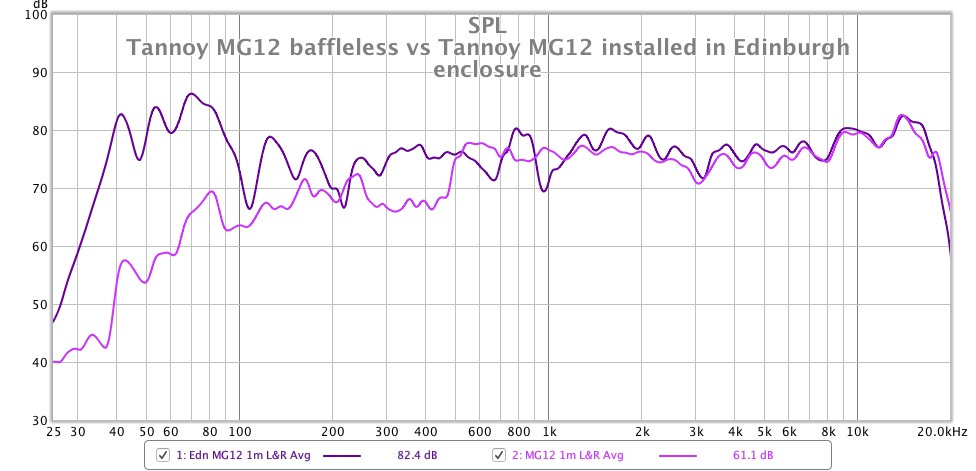

Fatmarley
"It appears my intelligence circuits have melted"
For the benefit of @Fatmarley, the following graph compares the response of the my MG12 drivers in free space (i.e. not mounted in any baffle or enclosure) and the response when installed in the Edinburgh enclosures, both measured from 1 metre. I have averaged the left & right drivers in both measurements to remove some variance. These measurements were taken in 2017/2018. Comments welcome.

It's very difficult to know what the problem is because there's very little information. If I simulate the baffle diffraction, it shows a peak from about 200hz to 700hz, so you'd think the dip was room related, but it may be a measurement error because you need to be far enough away to include baffle diffraction, and the wider the baffle, the further away you need to be. They are very wide baffles (26" x 40" according to somewhere on Google). With a baffle that wide It doesn't look like you need any BSC. Are you sure the problem isn't 70hz to 200hz?
ToTo Man
the band not the dog
Is that with respect to the nearfield measurement in post #25 or the listening position measurement in post #1?Are you sure the problem isn't 70hz to 200hz?
I know that measuring from 1 metre helps to reduce room effects, but by how much? i.e. I'm wonder if the elevated response at 70Hz is due to the speaker's position in the room (as you can see from post #1 they're very near the corners of the room), so perhaps that's corrupting the nearfield measurement below 100Hz?
I don't know exactly what the port tuning of the Edinburgh enclosure is as it's a distributed port system with narrow 'slots' rather than a conventional round port (the gothic-style detailing down each side of the cabinet are the ports). Altering the port tuning is therefore very difficult.
If you fancy some light reading I've uploaded some literature on the Edinburgh's design here, perhaps you can make more sense of it than I?
The Edinburgh was originally fitted with Tannoy "3149" 12-inch hard-edged drivers, which have an Fs=38Hz when new. One of the reasons I removed the 3149 drivers is the Fs rises significantly with age and when I last measured my Edinburghs with 3149 drivers installed the bass started rolling off at 125Hz! More importantly though I preferred the sound of the mid and high frequencies of the MG12 over the 3149, it was more phase coherent to my ears.
The hard-edged MG12 has an Fs=49Hz when new, though again this apparently rises with age. I haven't measured the Fs of mine, but I'm assuming it hasn't risen by as much as the 3149, given I'm still getting strong bass output from it down to 40Hz in the Edinburgh enclosure.
I have a pair of rubber-surround MG12 drivers in the cupboard still waiting to be installed somewhere. I wonder if these may fare better in the Edinburgh enclosure given they have a much lower Fs=27Hz? I can see a busy summer ahead of me!...
Fatmarley
"It appears my intelligence circuits have melted"
Is that with respect to the nearfield measurement in post #25 or the listening position measurement in post #1?
I know that measuring from 1 metre helps to reduce room effects, but by how much? i.e. I'm wonder if the elevated response at 70Hz is due to the speaker's position in the room (as you can see from post #1 they're very near the corners of the room), so perhaps that's corrupting the nearfield measurement below 100Hz?
I don't know exactly what the port tuning of the Edinburgh enclosure is as it's a distributed port system with narrow 'slots' rather than a conventional round port (the gothic-style detailing down each side of the cabinet are the ports). Altering the port tuning is therefore very difficult.
If you fancy some light reading I've uploaded some literature on the Edinburgh's design here, perhaps you can make more sense of it than I?
The Edinburgh was originally fitted with Tannoy "3149" 12-inch hard-edged drivers, which have an Fs=38Hz when new. One of the reasons I removed the 3149 drivers is the Fs rises significantly with age and when I last measured my Edinburghs with 3149 drivers installed the bass started rolling off at 125Hz! More importantly though I preferred the sound of the mid and high frequencies of the MG12 over the 3149, it was more phase coherent to my ears.
The hard-edged MG12 has an Fs=49Hz when new, though again this apparently rises with age. I haven't measured the Fs of mine, but I'm assuming it hasn't risen by as much as the 3149, given I'm still getting strong bass output from it down to 40Hz in the Edinburgh enclosure.
I have a pair of rubber-surround MG12 drivers in the cupboard still waiting to be installed somewhere. I wonder if these may fare better in the Edinburgh enclosure given they have a much lower Fs=27Hz? I can see a busy summer ahead of me!...
The only way to get accurate measurements below around 200hz is to take a nearfield measurement of the woofer about 5mm away from the centre of the cone, splice that to a nearfield port measurement and then splice to a gated farfield measurement that includes baffle diffraction. I'm not sure if it's even possible to take an accurate measurement of the Edinburgh because of the distributed ports (Onken?) - Well, not unless you can hoist them off the ground a long way up to remove boundaries. Another way to remove room affects is to take them to a large, empty, flat area (car park maybe) and put them on their side, and the microphone on the floor facing the tweeter, and measure like that. It's not something I've ever tried though.
Is there a smallish panel on the enclosure or something that you can remove to reveal a hole? Thinking off the top of my head - blocking ports will lower the tuning frequency, so you need to add them. They don't actually have to be a tube or tunnel, just an opening would do.
Fatmarley
"It appears my intelligence circuits have melted"
Continuing on from what I was saying on the other thread. I've uploaded some graphs to try to explain what I was talking about:
This first graph is the ideal enclosure size and tuning for a flat response with this driver (56ltr). Imagine we design a crossover to work with this tuning and that's going to be our crossover for the next examples I upload. In other words everything from 200hz and up, stays at the same level because the tuning doesn't affect the driver output, only the port output.

Next we increase the enclosure volume to 100ltr and also keep the port the same diameter and length.
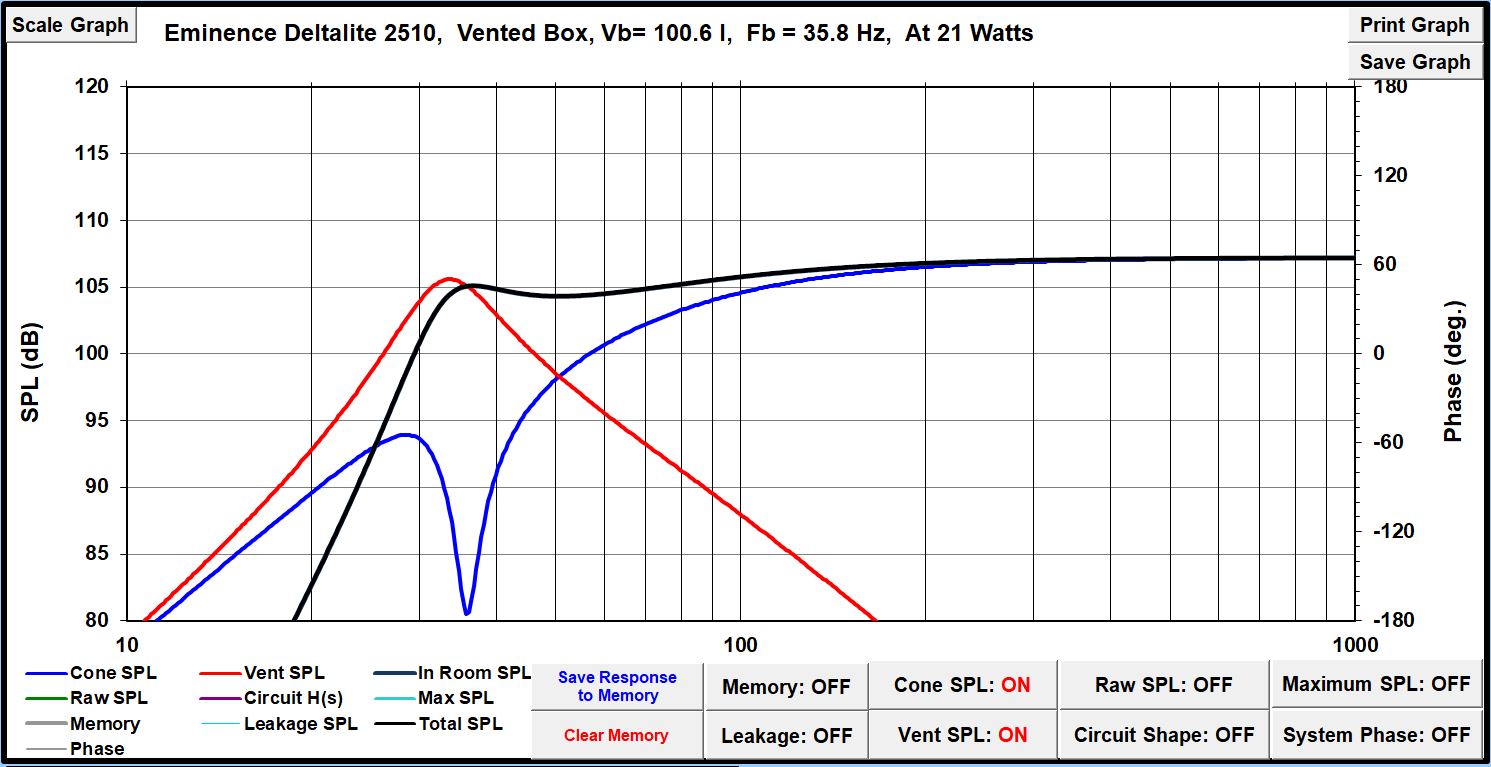
The lowest of low midrange, midbass/bass is now down in level compared to the rest of the frequency range. The crossover needs to be adjusted to bring the midrange (200hz and up) down to be inline with the bass from the port (or maybe corner loading would work?)
Next graph is the same but with a higher tuning to fill in that missing bass/midbass (what I was suggesting you try as a quick experiment)

Midbass is now fine, but we have a peak at the tuning frequency that's going to annoy on the odd track. Some will put this down to room, or just how ports sound, or the recording etc. You can stuff the hell out of the enclosure to reduce the peak (make sure there is a clear pathway for air to move through the port), Or you reduce the volume to 56ltr like in the first graph.
It may be possible to make the second graph sound OK with corner loading but it's not something I've ever looked in to.
You can go even smaller than 56ltr and tune higher. That is exactly what I did with the Deltalite 2510 (42ltr) because I wanted to hear what it sounded like when you took a large driver and tuned it like small standmounts are often tuned. It gave incredibly tight, fast bass that you could feel but obviously lacked a bit of depth. Thought they were fantastic fun but I have a speaker building addiction and no room for storage, so they had to go
This first graph is the ideal enclosure size and tuning for a flat response with this driver (56ltr). Imagine we design a crossover to work with this tuning and that's going to be our crossover for the next examples I upload. In other words everything from 200hz and up, stays at the same level because the tuning doesn't affect the driver output, only the port output.

Next we increase the enclosure volume to 100ltr and also keep the port the same diameter and length.

The lowest of low midrange, midbass/bass is now down in level compared to the rest of the frequency range. The crossover needs to be adjusted to bring the midrange (200hz and up) down to be inline with the bass from the port (or maybe corner loading would work?)
Next graph is the same but with a higher tuning to fill in that missing bass/midbass (what I was suggesting you try as a quick experiment)

Midbass is now fine, but we have a peak at the tuning frequency that's going to annoy on the odd track. Some will put this down to room, or just how ports sound, or the recording etc. You can stuff the hell out of the enclosure to reduce the peak (make sure there is a clear pathway for air to move through the port), Or you reduce the volume to 56ltr like in the first graph.
It may be possible to make the second graph sound OK with corner loading but it's not something I've ever looked in to.
You can go even smaller than 56ltr and tune higher. That is exactly what I did with the Deltalite 2510 (42ltr) because I wanted to hear what it sounded like when you took a large driver and tuned it like small standmounts are often tuned. It gave incredibly tight, fast bass that you could feel but obviously lacked a bit of depth. Thought they were fantastic fun but I have a speaker building addiction and no room for storage, so they had to go
ToTo Man
the band not the dog
Is there a smallish panel on the enclosure or something that you can remove to reveal a hole? Thinking off the top of my head - blocking ports will lower the tuning frequency, so you need to add them. They don't actually have to be a tube or tunnel, just an opening would do.
Yes, funnily enough when I installed the MG12 drivers I removed the Edinburgh's binding posts backplate so I could feed the MG12 cable out to its crossover externally. The rectangular cutout, 125mm x 65mm x 19mm, is currently covered over with a piece of thin plywood I blu-tacked on, leaving just a small hole for the cable. I did run FR sweeps before and after covering the hole and observed no change in the bass response (though I probably wasn't looking at frequencies above 100Hz at the time in these tests). I wonder if this is because there's also internal foam damping covering the cutout, which is preventing or at least impeding the airflow?
ToTo Man
the band not the dog
Continuing on from what I was saying on the other thread. I've uploaded some graphs to try to explain what I was talking about:
This first graph is the ideal enclosure size and tuning for a flat response with this driver (56ltr). Imagine we design a crossover to work with this tuning and that's going to be our crossover for the next examples I upload. In other words everything from 200hz and up, stays at the same level because the tuning doesn't affect the driver output, only the port output.

Next we increase the enclosure volume to 100ltr and also keep the port the same diameter and length.

The lowest of low midrange, midbass/bass is now down in level compared to the rest of the frequency range. The crossover needs to be adjusted to bring the midrange (200hz and up) down to be inline with the bass from the port (or maybe corner loading would work?)
Next graph is the same but with a higher tuning to fill in that missing bass/midbass (what I was suggesting you try as a quick experiment)

Midbass is now fine, but we have a peak at the tuning frequency that's going to annoy on the odd track. Some will put this down to room, or just how ports sound, or the recording etc. You can stuff the hell out of the enclosure to reduce the peak (make sure there is a clear pathway for air to move through the port), Or you reduce the volume to 56ltr like in the first graph.
It may be possible to make the second graph sound OK with corner loading but it's not something I've ever looked in to.
You can go even smaller than 56ltr and tune higher. That is exactly what I did with the Deltalite 2510 (42ltr) because I wanted to hear what it sounded like when you took a large driver and tuned it like small standmounts are often tuned. It gave incredibly tight, fast bass that you could feel but obviously lacked a bit of depth. Thought they were fantastic fun but I have a speaker building addiction and no room for storage, so they had to go
I see what you mean about the dipped upper bass response, but from the graphs you posted I'd expect this to be inaudible above 150Hz or so?
Reducing the Edinburgh's internal volume from ~200L to ~60L would take some doing! I'd probably be better off just putting the MG12s in smaller cabs? Given that I have stereo subwoofers, I could probably even forego the added complication of ports and just go with sealed cabs? They would take up less space and should make subwoofer integration easier too.
I assume making the 200L Edinburgh enclosure a sealed design wouldn't increase the upper bass / lower midrange output, it would simply provide a smooth 12dB/oct roll-off and push the -3dB point quite high up?
I'd be interested to see the Fs=27Hz (rubber surround) MG12 modelled in a 200L distributed port enclosure. I don't suppose either you or @cooky1257 could give me an idea of the bass curve I might expect to see?
Regarding your comment on tuning the crossover to account for different baffle step and enclosure volumes, all of the graphs I've posted on this thread are pre-EQ. I do tweak all of my speakers with digital parametric EQ to provide my desired response at the listening seat. Rather peculiarly though, the 100Hz-400Hz recession shown in the first graph in post #1 suggests it's down by 4dB or 5dB from where it should be. Yet when I apply EQ to this area, I find that boosting it by more than 1.5dB or 2dB just sounds plain wrong, so I do think that particular graph is somewhat misleading, either that or I have been conditioned over time to prefer a leaner balance in this area!...
Last edited:
Fatmarley
"It appears my intelligence circuits have melted"
Yes, funnily enough when I installed the MG12 drivers I removed the Edinburgh's binding posts backplate so I could feed the MG12 cable out to its crossover externally. The rectangular cutout, 125mm x 65mm x 19mm, is currently covered over with a piece of thin plywood I blu-tacked on, leaving just a small hole for the cable. I did run FR sweeps before and after covering the hole and observed no change in the bass response (though I probably wasn't looking at frequencies above 100Hz at the time in these tests). I wonder if this is because there's also internal foam damping covering the cutout, which is preventing or at least impeding the airflow?
The port will only affect frequencies below roughly 200hz and these are the frequencies most difficult to measure. Anything blocking airflow, even near the port, let alone in or against it, will stop the port working properly.
In the past I've downloaded test tones - say 20hz 30hz 40hz (or whatever frequencies are of interest) and just sat in there listening position, skipping through to see where the peaks and dips are. I find doing it this way more accurate than farfield measurements.
Fatmarley
"It appears my intelligence circuits have melted"
I see what you mean about the dipped upper bass response, but from the graphs you posted I'd expect this to be inaudible above 150Hz or so?
Reducing the Edinburgh's internal volume from ~200L to ~60L would take some doing! I'd probably be better off just putting the MG12s in smaller cabs? Given that I have stereo subwoofers, I could probably even forego the added complication of ports and just go with sealed cabs? They would take up less space and should make subwoofer integration easier too.
I assume making the 200L Edinburgh enclosure a sealed design wouldn't increase the lower midrange output anyway, it would simply provide a smooth 12dB/oct roll-off and push the -3dB point quite high up?
I'd be interested to see the Fs=27Hz (rubber surround) MG12 modelled in a 200L distributed port enclosure. I don't suppose either you or @cooky1257 could give me an idea of the bass curve I might expect to see?
Regarding your comment on tuning the crossover to account for different baffle step and enclosure volumes, all of the graphs I've posted on this thread are pre-EQ. I do tweak all of my speakers with EQ to provide my desired response at the listening seat. Rather peculiarly though, the 100Hz-400Hz recession shown in the first graph in post #1, suggests it's down by 4dB or 5dB from where it should be. Yet when I apply EQ to this area, I find that boosting it by more than 1.5dB or 2dB just sounds plain wrong, so I do think that particular graph is somewhat misleading, either that or I have been conditioned over time to prefer a leaner balance in this area!...
I'm not suggesting you reduce the volume from 200ltr to 60ltr. The graphs I posted were just an example to give you an idea of what happens when you change enclosure volume and tuning. If it were me, I'd want to know what the optimum enclosure volume and tuning would need to be to work with those drivers and crossovers. There should be a standard Tannoy enclosure that works best. Removing a panel from the Edinburgh is just a quick and easy way to experiment, but may do nothing.
I'm pretty sure a sealed box would only make your problem worse, but if you add a subwoofer or two that can be crossed high that could be an option.
I would need the Thiele-Small Parameters for the driver and the port tuning frequency to model the rubber surround MG12 - But that still doesn't give us the whole picture because we don't know what the crossover is doing to the frequency response.
From what you're saying regarding EQ in the 100hz-400hz area, it does sound to me like the graphs are misleading, and simulations also suggest that - but I can only guess.
ToTo Man
the band not the dog
Thanks, I'll try that with the rear plate blocked and open and see what the difference is.Forgot to say - To find out the port tuning frequency, put your microphone about 5mm away from the centre of the woofer and run a sweep. The notch in the frequency response is the tuning frequency.
ToTo Man
the band not the dog
Time to update with some measurements! 
First is a measurement of both speakers in their respective positions in the room, but measured with the mic at a distance of 1mm (yes that's 1 millimetre, not 1 metre!) from the front grille.
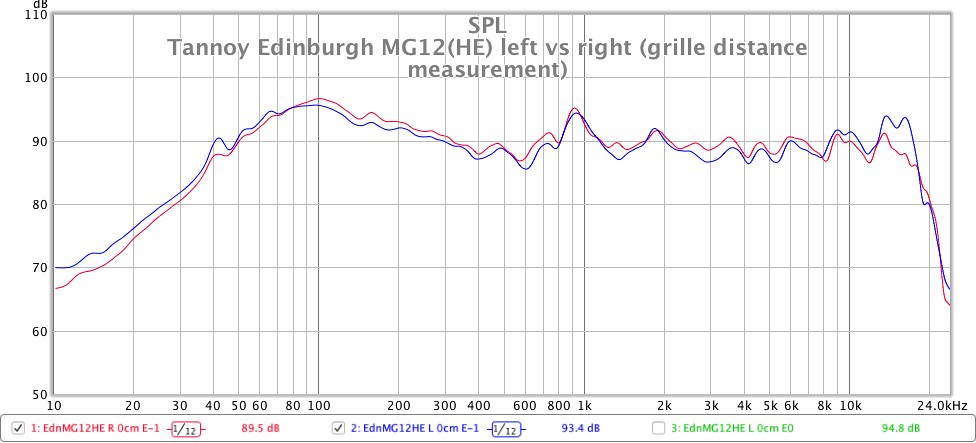
I was hoping this would reveal the tuning frequency of the enclosure, but I don't think it's close enough so I'll repeat later with the grilles removed and mic as close to the dust cap as possible.
What it does however reveal is the extent of pair matching between the two drivers, which as I mentioned before is rather excellent by vintage Tannoy standards.
Below 100Hz I suspect the room is still making itself known, as you can see ripples in the response around 40Hz-60Hz (my axial room modes are 41Hz, 45Hz and 53Hz).
Increasing the Energy control on the left speaker from -1 to Level results in a perfectly matched midrange response between the two speakers, but it also increases the disparity above 8kHz.

I currently run both speakers with the Energy set to -1 and use EQ to match the responses. I shelf down the >8kHz treble on the left speaker, and use a notch to reduce the upper mids on the right speaker.
Running the left speaker with the Energy control set to Level would remove the need to EQ the mids on the right speaker, but I think I actually prefer the slightly dipped mids that the -1 setting provides so will probably leave them both on -1.
First is a measurement of both speakers in their respective positions in the room, but measured with the mic at a distance of 1mm (yes that's 1 millimetre, not 1 metre!) from the front grille.

I was hoping this would reveal the tuning frequency of the enclosure, but I don't think it's close enough so I'll repeat later with the grilles removed and mic as close to the dust cap as possible.
What it does however reveal is the extent of pair matching between the two drivers, which as I mentioned before is rather excellent by vintage Tannoy standards.
Below 100Hz I suspect the room is still making itself known, as you can see ripples in the response around 40Hz-60Hz (my axial room modes are 41Hz, 45Hz and 53Hz).
Increasing the Energy control on the left speaker from -1 to Level results in a perfectly matched midrange response between the two speakers, but it also increases the disparity above 8kHz.

I currently run both speakers with the Energy set to -1 and use EQ to match the responses. I shelf down the >8kHz treble on the left speaker, and use a notch to reduce the upper mids on the right speaker.
Running the left speaker with the Energy control set to Level would remove the need to EQ the mids on the right speaker, but I think I actually prefer the slightly dipped mids that the -1 setting provides so will probably leave them both on -1.
Last edited:
jtgofish
pfm Member
Very interesting.It does tie in with my experience that the vintage Tannoys tend to sound best in boxes which are considerably larger than would be considered technically optimal.Other than the HPD 315s which seem to be quite happy in an original Cheviot sized box.
I made a pair of 150 litre lossy style boxes using 12mm ply with bitumen damping pads BBC style for some Gold 12s and they sounded pretty terrible.Clearly I should have tried a 200 litre more rigid boxes.Although some 270 litre boxes were too big and not right either.
You could have trimmed back the hole by using a straight cut router bit with a bottom bearing and using a smaller bearing.Then a top mount bearing straight cut router bit to remove the bottom section.That must have been a ridiculous amount of filing and sanding!
I made a pair of 150 litre lossy style boxes using 12mm ply with bitumen damping pads BBC style for some Gold 12s and they sounded pretty terrible.Clearly I should have tried a 200 litre more rigid boxes.Although some 270 litre boxes were too big and not right either.
You could have trimmed back the hole by using a straight cut router bit with a bottom bearing and using a smaller bearing.Then a top mount bearing straight cut router bit to remove the bottom section.That must have been a ridiculous amount of filing and sanding!
ToTo Man
the band not the dog
I took a measurement with the mic literally 1mm from the dust cap, expecting to see a deep notch in the response like the graphs in @Fatmarley's post #24, but there's nothing apart from a tiny dip at 46Hz.
I then tried taking a measurement with the mic against one of the enclosure's side vents. This time I expected to see a response peak, but there's no peak, only a notch. What does this mean?
FYI - No smoothing has been applied to either measurement.
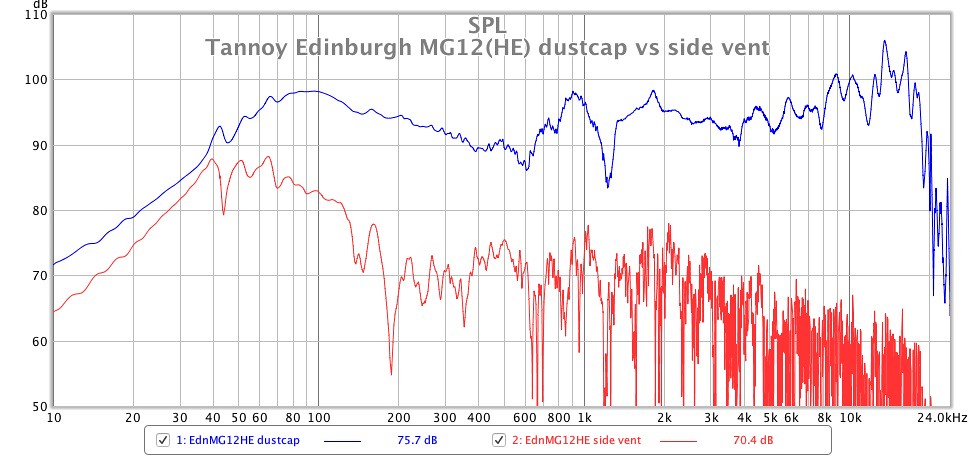
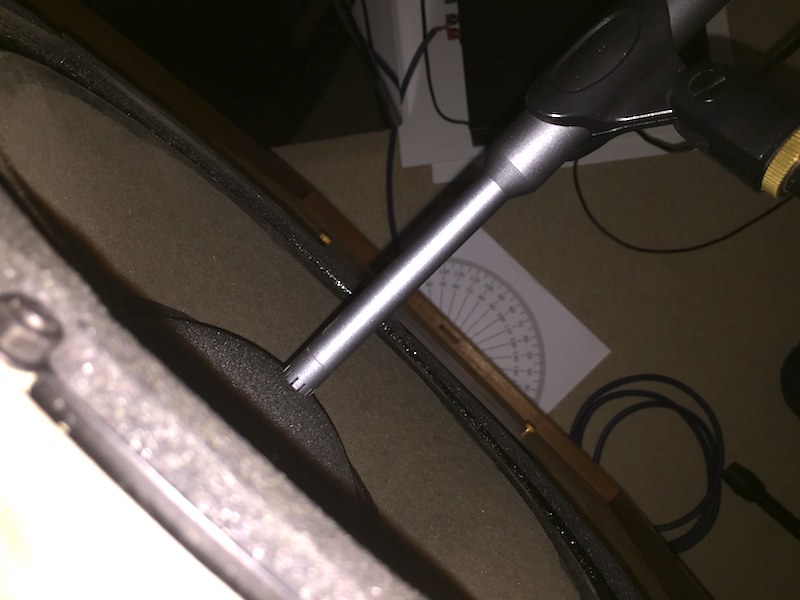
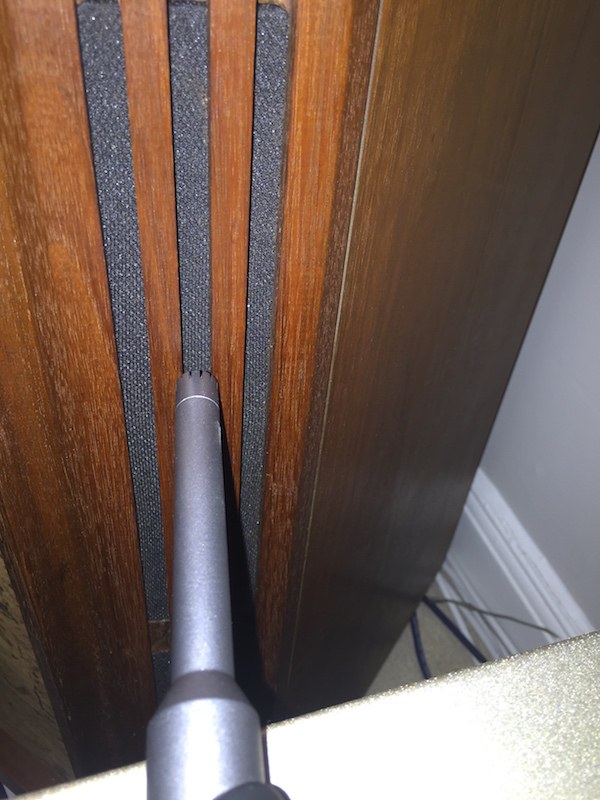
I then tried taking a measurement with the mic against one of the enclosure's side vents. This time I expected to see a response peak, but there's no peak, only a notch. What does this mean?
FYI - No smoothing has been applied to either measurement.



The Finisher
Must have shot a robin
I have the SRM12x ( 3149 drivers )and I’ve always thought that the cabs look like they should be an additional 3” deeper, best speakers I’ve ever had though ( and I’ve have plenty)
Tony L
Administrator
I then tried taking a measurement with the mic against one of the enclosure's side vents. This time I expected to see a response peak, but there's no peak, only a notch. What does this mean?
I’m only partially understanding this thread and what you are trying to achieve, but surely taking separate/independent close-mic measurements of the cone (front-wave) and the port (backwave) will miss or dramatically negate any phase-cancellation that will happen in reality when you are listening to the whole. The key is how the port interacts with the direct sound.

